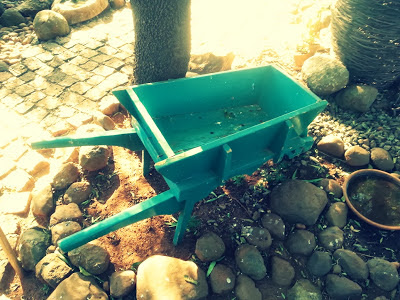Mollie's skin hanging outside on a tree
Snakes generally shed their skin several times a year, and young growing snakes shed even more frequently. A shed skin is much longer than the snake that shed it due to the fact that the skin covers the top and bottom of each scale. If the skin is shed intact, each scale is unwrapped on the top and bottom side of the scale which almost doubles the length of the shed skin. While a snake is in the process of shedding the skin over its eye can become milky. This impairs the vision of the snake and as a result most snakes will become more aggressive due to the snake feeling more vulnerable.
Mollie has been living at my pond on and off for the past few years and is a most welcome resident as she keeps my garden free of rats. She comes and goes as she pleases and sometimes I won't see her for weeks on end, like now in winter. She does have an old rat hole in the pond area that she prefers to frequent and I'll often see her lying in the sun just in front of it.
Whether shedding their skins or not, Mole Snakes, which are not poisonous, are normally aggressive, much more so than the harmless Brown House Snake for example. When being approached, Mollie rears up like a Cobra and hisses, which often confuses people and can spell disaster for this harmless species. Her yellow colouration (and they can be black as well) is also similar to that of some cobras, but she does not have the large tell-tale hood cobra's are so renowned for.
Cape cobras are Africa’s most venomous cobra and Mole snakes, although they can give a painful bite, are non-venomous. If you find a snake while walking outdoors, enjoy the encounter by taking some photographs but give the animal some respect and leave it be. Unless there is the potential for conflict there is no reason to prod, poke or harass a snake in any way. Doing so is literally asking for trouble.
The way to tell the difference between these two species is to look at the size and shape of the head. The mole snake spends much of its life underground; it’s a burrowing species with a relatively small elongated head and pointed snout perfect for this lifestyle. The cape cobra has a broad head and an almost rounded ‘cheek’ or temporal area.
The mole snake (Pseudaspis cana) is a species of snake in the family Colubridae. It is native to much of southern Africa, and is the only member of the genus Pseudaspis. In the south of South Africa mole snakes tend to be black or dark brown, while in the north they are brown, reddish brown, yellow or grey. Mole snakes hiss loudly and strike when threatened. Average size 1.2 – 1.6m but may reach lengths of 2m.
.
































